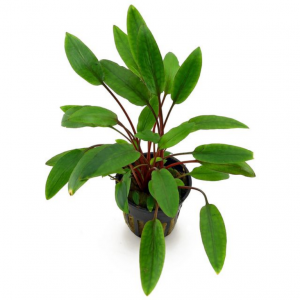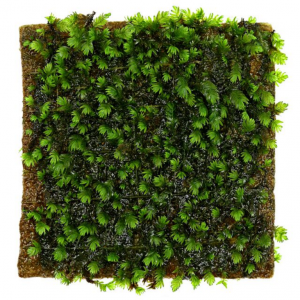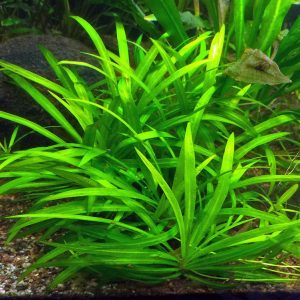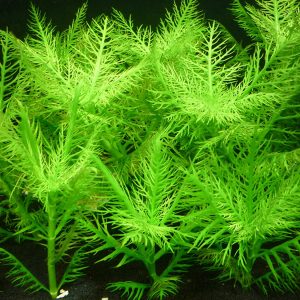aquascape plants
Showing 73–96 of 137 results
-
Plants, Potted
Cryptocoryne Axelrodi
Common Name: Cryptocoryne Axelrodi
Crypt Axelrodi is a rarer Cryptocoryne species that features narrow leaves, hardy nature and a greenish-brown color. It works great for mid ground plant coverage in planted tanks and is easy to care for. However, we’d recommend that it is not moved like most crypts as this can potentially trigger Crypt melt.
Like other crypts, Cryptocoryne Axelrodi is great for beginner hobbyists due to its ease in keeping and low care requirements. If grown in good aquarium substrate such as Ultum Nature System Controsoil, the plant can feed through the roots and grow quickly without the need for high light, CO2 or fertilizer dosing. However, the addition of CO2 and good lighting will result in healthier, more robust growth.
Crypts can be grown emersed or submerged. Propagate by splitting the rhizome or cutting off new growth and replanting
Difficulty easy Usage Midground, Foreground, group Growth medium pH value 5 – 8 Temperature tolerance 15 – 28°C Carbonate hardness 1 – 18°dKH General hardness 0 – 30°dGH Propagation Runners, Rhizomteilung, Splitting, cutting off daughter plants Can grow emersed? yes SKU: n/a -
Sold out!Plants, Potted
Cryptocoryne beckettii “Petchii”
Cryptocoryne beckettii “Petchii” a small variety of Cryptocoryne beckettii from Sri Lanka, which has beautiful, slightly fluted leaf margins, 10-15 cm long. Leaves become dark olive-brown with violet underside. Like many other Cryptocorynes, the leaf colour and shape depends largely on environmental conditions in the aquarium.
ORIGIN: Sri Lanka
MAX HEIGHT: 10-15cm
GROWTH RATE: Slow
AREA: Foreground to midground
LIGHT: Low
TEMP: 22-28
CO2: Recommended but not essential
PH: 5-8
DIFFICULTY: Easy
WATER HARDNESS: Soft to hardSKU: n/a -
Plants, Potted
Cryptocoryne parva Dwarf water trumpet in pot
Cryptocoryne parva is the smallest Crypt. It is native to Sri Lanka where it grows at the edges and in the shallow water of fast flowing rivers. It forms dense, extended lawns with its underground runners. This species forms the hybrid Cryptocoryne x willisii with species from the same area such as C. beckettii. It is known in the aquarium hobby for a long time and belongs to the standard range of the water plant nurseries.
- The smallest Crypt
- Forms narrow-leaved cushions or lawns
- Robust, slow-growing
Difficulty medium Usage Nano tanks, Foreground, group, Foreground, ground cover Aquascaping forms a grass-like lawn Growth very slow pH value 5 – 8 Temperature tolerance 15 – 28°C Carbonate hardness 1 – 18°dKH General hardness 0 – 30°dGH Propagation Runners, Rhizomteilung, Splitting, cutting off daughter plants Can grow emersed? yes SKU: n/a -
Plants, Potted
Cryptocoryne undulatus red
Cryptocoryne undulatus red is a type of aquarium plant commonly known as the “red wendtii” or “red crypt.” It belongs to the genus Cryptocoryne, which consists of various species known for their stunning appearance and ability to thrive in aquatic environments
SKU: n/a -
Sold out!Plants, Tissue Culture Cup
Cryptocoryne wendtii ‘Green’
Cryptocoryne wendtii ‘Green’
Buy Cryptocoryne wendtii ‘Green’ in Dubai, Abudhabi, and all over UAE.
Robust time-tested Crypt
- Forms dense groups
- Green to slightly brown hues
Difficulty easy Usage Midground, Foreground, group Growth medium pH value 5 – 8 Temperature tolerance 15 – 30°C Carbonate hardness 1 – 18°dKH General hardness 0 – 30°dGH Propagation Runners, Rhizomteilung, Splitting, cutting off daughter plants Can grow emersed? yes Buy 5 or more for additional discount!
Buy 10 or more to get super discount!
SKU: n/a -
Sold out!Plants, Tissue Culture Cup
Didiplis diandra in vitro cup
A graceful stem plant from North America that is nice as dense bush planting in the fore- or middle ground. Under water its shoots develop very dense foliage and very narrow leaves. Under good light, the shoot tips assume a reddish colour.
- Delicate stem plant with dense foliage
- Bushy and relatively low-growing
- Bright reddish colour under lots of light
Difficulty medium Usage Midground, Nano tanks, Street (Dutch style), Foreground, group Aquascaping well-branched, bushy Growth fast pH value 5 – 7 Temperature tolerance 4 – 30°C SKU: n/a -
Live Plants & Neutrients, Plants, Potted
Echinodorus ‘Aquartica’
This compact, green, low-growing Echinodorus cultivar was developed by the plant breeder Christian Iversen from Aquartica company in Denmark. Under aquarium conditions, it forms a spreading rosette of broadly elliptic, medium green leaves with wavy margin. In stark contrast to the many vigorously growing, large swordplants, it is even suited for the foreground and for nano aquariums as it gets only 10-20 cm. Furthermore it grows quite slowly and contents with only moderate light intensity.
This plant is mostly delivered in its emersed (terrestrial) stage, with more roundish, longer stalked leaves. Planted into the aquarium, it will develop its typical submerged growth habit.- Recommendable low-growing Echinodorus cultivar
- 10-20 cm tall
- Medium-green leaves with wavy edge
- Also suited for the foreground and nano aquariums
SKU: n/a -
Sold out!Live Plants & Neutrients, Plants, Potted
Echinodorus ‘Red Chameleon’ pot
Echinodorus ‘Red Chameleon’ is an excellent choice to add a new color to your aquarium. Red Chameleon offers an interesting red hue which makes it an extremely sought after aquatic plant. It is one of the more compact and slower growing sword plants allowing it to be planted in midground areas of the aquarium.
Depending on lighting, colour will vary from Dark/ Red pink
SKU: n/a -
Sold out!Plants, Potted
Echinodorus Bleheri / Amazon Sword
- Echinodorus is a very hardy species of aquatic plants. Most Echinodorus require nutrient-dense soil to thrive as they are heavy root feeders.
- Echinodorus grow fairly large and are more suitable for larger planted aquariums.
- Do not make drastic changes to the aquarium. Unstable parameters will result in melt and rotting of the aquarium plant.
- Please be sure to remove this plant from its pot. Remove the cotton surrounding the roots and plant into a quality substrate. For instructions on how to properly prep “potted” aquarium plants, click here.
- CO2 injection and quality aquarium soil will yield better growth.
- Please research appropriately to ensure your plant thrives.
Family Name: Alismataceae
Origin: South America
Height: 4-20”
pH: 6.5-7.5
Care: Easy
Light: Moderate
Co2: Not necessary
Propagation: Adventitious shoots
Growth rate: Fast
SKU: n/a -
Live Plants & Neutrients, Plants, Potted
Echinodorus Cordifolius ‘Fluitans’
- Large, entirely green solitary plant
- Elongate, ovate leaves
- No high demands
- Comparatively fast growing
This sword plant is labeled by the nursery Tropica as Echinodorus cordifolius ‘Fluitans’. According to Tropica it originates from Mexico. In contrast to “typical” Echinodorus cordifolius, “Fluitans” does not have roundish, deeply heart-shaped, but elongate, ovate leaves. It does not grow out of the water as readily as several other E. cordifolius forms, making it a well-suited submerged aquarium plant. This Echinodorus forms a lush, about 30-50 cm tall and at least 30 cm wide leaf rosette. The submerged foliage is light to medium green, newly appearing leaves may show slightly reddish tones.
The plant is mostly delivered in its emersed (terrestrial) form with long stalked aerial leaves, but after planting into the tank shorter stalked submerged leaves will appear, and the older emersed foliage can be cut off. As well as other Echinodorus, it benefits much from nutrient supply by the substrate. There are no special demands on the water chemistry; it grows well in soft to medium hard water with temperatures around 20-28 °C. CO2 supply is not strictly necessary but may enhance its growth. Under favorable conditions inflorescences with adventitious plantlets can be expected. When the young plants are strong enough, they can be cut off and replanted.
Echinodorus cordifolius “Fluitans” is primarily a solitary plant for the midground to background, due to its size best in larger, spacious, at least 50 cm high aquariums. In contrast to the many red or strikingly spotted Echinodorus hybrid cultivars, it has a natural appearance due to its green coloration.
SKU: n/a -
Live Plants & Neutrients, Plants, Potted
Echinodorus Rose
Echinodorus ‘Red Diamond’ was bred in the Ukraine and is probably a cross between Echinodorus horemanni ‘Red’ and Echinodorus x barthii. The resultant hybrid is an attractive, relatively small plant with ruby-red sword-shaped leaves, 15-25 cm long.
Unlike many other sword plants, Echinodorus ‘Red Diamond’ remains moderate in size (20-30 cm wide rosette), so it is extremely well suited as a solitary plant, even in small aquariums. Increasing the nutrients in the substrate results in more abundant growth, while favourable light conditions promote the formation of the ruby-red leaves.
- Red leaves, dark red nerves
- Narrowly egg-shaped leaves
- Relatively low
- Also suitable for small tanks
Genus Echinodorus Difficulty medium Usage Background, Midground Growth medium pH value 5 – 7 Temperature tolerance 15 – 30°C Carbonate hardness 0 – 21°dKH General hardness 0 – 30°dGH Propagation Proliferating inflorescences, Rhizomteilung Can grow emersed? yes SKU: n/a -
Sold out!Plants, Potted
Eleocharis vivipara Tall hairgrass
The Tall Hairgrass forms hair-thin long leaves. On the leaf tips, adventitious plants are formed. Eleocharis vivipara is ideal for planting higher “meadows” in the back of the aquascape.
Difficulty easy Usage Background, Midground Growth medium pH value 4 – 7 Temperature tolerance 5 – 29°C Carbonate hardness 2 – 5°dKH General hardness 0 – 30°dGH Propagation Proliferating inflorescences, Splitting, cutting off daughter plants SKU: n/a -
Live Plants & Neutrients, Plants, Potted
Fissidens fontanus “Phoenix Moss” on pad
- Also labeled “Fissidens geppii”
- Highly decorative aquatic moss
- Feathery appearance
- Dark green coloration
- Also suitable for cold water tanks
Fissidens fontanus is a delicate feathery dark green aquatic moss clinging to driftwood or rocks with its rhizoids, forming roundish cushions or lawn-like populations. It is also known under the synonym Octodiceras fontanum and in the trade as “Fissidens geppii”. We cultivate two variants of this species, which differ in size when growing in the same environment. The smaller variant is what we call “Phoenix moss”. It develops around 3 to 5 mm long leaflets, is of a somewhat darker green and has an overall more delicate growth habit and looks more compact as it branches more readily than the larger variant.
Difficulty easy Usage Epiphyte (growing on hardscape), Midground, Nano tanks, Foreground, group Aquascaping fine-leaved Growth medium pH value 5 – 7 Temperature tolerance 4 – 26°C Carbonate hardness 0 – 14°dKH SKU: n/a -
Sold out!Plants, Potted
Fissidens sp. “Mini Nobilis”
This small Fissidens moss entered the trade as Fissidens nobilis or F. nobilis “Mini” but belongs with certainty not to the much larger, stronger species Fissidens nobilis from Asia. belongs to a different species. It develops about 2 mm broad shoots that are densely set with tiny leaves. With time, it forms thick, fluffy cushions of many shoots.
- Small, filigree Fissidens
- Fine, feather-like structure
- Forms thick, fluffy cushions
- Very rare in trade
SKU: n/a -
Sold out!Live Plants & Neutrients, Plants, Tissue Culture Cup
Glossostigma elatinoides
- The most popular ground covering plant there is
- Forms intense green carpets
- Fast grower
Glossostigma elatinoides is a very popular plant for Japanese-style tanks. It is one of the smallest aquarium plants, which makes it ideal for the foreground. A difficult-to-care-for plant that needs a lot of light. If the lighting is too weak, it tends to grow upwards. Must not be shaded off by larger plants. When planting, make small tufts (approx. 1/8 of the pot) and plant at a distance of only a few centimetres. Thus you will get a ground-covering group in less time. The injection of CO2 and soft water enhance growth considerably.
Genus Glossostigma Difficulty medium Usage Nano tanks, Foreground, group, Foreground, ground cover Aquascaping forms a small-leaved carpet Growth fast pH value 4 – 7 Temperature tolerance 4 – 30°C Carbonate hardness 0 – 14°dKH General hardness 0 – 30°dGH Propagation Runners, Cuttings, Splitting, cutting off daughter plants Can grow emersed? yes SKU: n/a -
Plants, Tissue Culture Cup
Helanthium “quadricostatus” Chain sword
- Bright light green ground cover
- Height ca. 5-10 cm
- Fast growing
- Not demanding
Also known as Echinodorus magdalenensis and E. quadricostatus. This light green plant is quite undemanding and recommendable as fast growing ground cover. The name “Echinodorus quadricostatus” is a trade name for various varieties of Helanthium bolivianum.
Genus Helanthium Difficulty easy Usage Midground, Nano tanks, Foreground, group, Foreground, ground cover Aquascaping forms a grass-like lawn Growth fast pH value 5 – 7 Temperature tolerance 10 – 30°C Carbonate hardness 0 – 14°dKH General hardness 0 – 30°dGH Propagation Runners Can grow emersed? yes SKU: n/a -
Sold out!Live Plants & Neutrients, Plants, Potted
Hygrophila balsamica
Hygrophila balsamica
- Large stem plant with finely divided leaves
- Light green coloration
- Bushy growth after trimming
Genus Hygrophila Difficulty easy Usage Midground Aquascaping fine-leaved Growth fast pH value 5 – 7 Temperature tolerance 18 – 30°C Carbonate hardness 2 – 12°dKH General hardness 0 – 30°dGH Propagation Cuttings Can grow emersed? yes BUY MORE SAVE MORE!
Buy 5 or more for additional discount!
Buy 10 or more to get super discount!
SKU: n/a -
Live Plants & Neutrients, Plants, Potted
Hygrophila polysperma ‘Rosanervig’
Hygrophila polysperma ‘Rosanervig’
- Light leaf veins
- Light green, yellowish to red hues
- Easy to cultivate
Difficulty very easy Usage Midground Aquascaping very colourful plant for accents Growth very fast pH value 5 – 8 Temperature tolerance 4 – 35°C Carbonate hardness 2 – 21°dKH General hardness 0 – 30°dGH Propagation Cuttings Can grow emersed? yes BUY MORE SAVE MORE!
Buy 5 or more for additional discount!
Buy 10 or more to get super discount!
SKU: n/a -
Live Plants & Neutrients, Plants, Potted
Lace Plant Aponogeton madagascariensis var. henkelianus
Lace Plant Aponogeton madagascariensis var. henkelianus
- One of the most beautiful Lace plant forms
- Broad leaves with delicate grid structure
- Eyecatcher in larger tanks
This fascinating variant of the Madagascar laceplant is also known as Aponogeton madagascariensis var. henkelianus. It lives up to its name “laceplant” or “laceleaf”: the broad leaves have a delicate grid structure, the leaf tissue is reduced to the thin nerves. The larger perforations are divided by smaller, irregularly arranged connecting nerves. As a solitary plant or small, loose group in the midground or background, Aponogeton madagascariensis “henkelianus” draws all eyes.
The forms of Aponogeton madagascariensis originate from cool, fast flowing, permanent rivers in Madagaskar. They prefer cooler water below 25 °C, good water movement, CO2 supply and nutrient-rich bottom. Medium lighting is sufficient.
SKU: n/a -
Sold out!Plants, Tissue Culture Cup
Lilaeopsis brasiliensis Brazilian micro sword
- Grasslike ground covering plant
- Slow-growing
- Adaptable
Lilaeopsis brasiliensis can grow very densely, but it only grows like a lawn under very intensive light. When planting, make small tufts and put them into the ground with a distance of only a few centimetres, as the plants form an uninterrupted lawn more easily this way. The planted area should be without shade so the plants get sufficient light. Also suitable for a garden pond, and it tolerates the low salinity of a brackish water aquarium.
Genus Lilaeopsis Difficulty medium Usage Nano tanks, Foreground, group, Foreground, ground cover Aquascaping forms a grass-like lawn Height 3 – 6cm Growth medium pH value 6 – 7 Temperature tolerance 4 – 28°C Carbonate hardness 2 – 14°dKH General hardness 0 – 30°dGH Propagation Runners, Splitting, cutting off daughter plants Can grow emersed? yes SKU: n/a -
Sold out!Plants, Potted
Limnophila hippuridoides in pot
A beautiful stem plant from the Malayan peninsula, often erroneously called Limnophila aromatica. This strong, fast-growing Limnophila is a true eye-catcher when planted in a group in the middle or background of a tank. Intensive light, a good nutrient and CO2 supply are important for the well-being of this plant.
Difficulty medium Usage Accent (red), Background, Midground Aquascaping very colourful plant for accents Growth fast pH value 6 – 7 Temperature tolerance 15 – 30°C Carbonate hardness 2 – 12°dKH General hardness 0 – 30°dGH Propagation Cuttings Can grow emersed? yes SKU: n/a

























